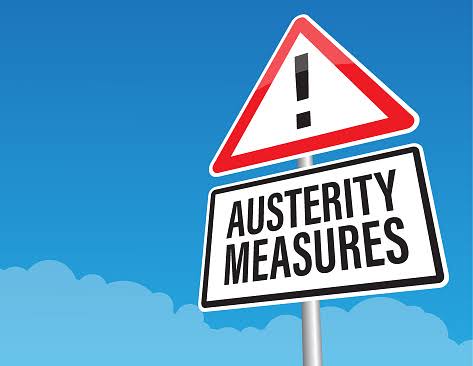
By Shiza Zahid
Austerity refers to a set of economic policies that a government implements to control the public sector debt. They are a special subset of contractionary fiscal policy, which focuses on changing the aggregate demand and specifically targets cyclical and structural budget deficits, aiming for debt minimization. Governments implement austerity measures when they are concerned that their national debt is so substantial that there is a valid possibility of ‘default’ or concerns regarding servicing the debt. Its two main tools of increasing taxation and/or decreasing government spending are largely viewed, in theory, as a necessary evil without which the continuous increase in public debt can “cripple” the economy of a country. While proponents argue that they are essential to gain financial stability, critics side the opposite stating that they cause more harm than good, especially for Pakistan’s economy.
Advocates comment that these effects are not confined only to the demand side of the economy but also have positive and reaffirming supply-side benefits. Joseph Schumpeter’s theory of economic innovation and entrepreneurship states that although in the short run, a decrease in aggregate demand leads to challenges such as reduced consumption, investment, and employment. It can as a response lead to pressures for efficiency and innovation. His coined term “creative destruction” describes the process in which innovations take the place of older ones, as they become outdated. This results in businesses reducing costs, increasing efficiency, and enhancing productivity through technological developments to compete in a burdensome environment. Therefore, in the long term, these policies lead to a leaner and more competent economy that benefits consumers, investors, and the government.
Moreover, these measures may also result in improved relations and restored investor confidence in the economy. When an economy takes these steps, it is a gauge that they are implementing strategies to nurse their financial health back to suitable levels and thus, they may become optimistic to invest. Therefore, lenders are more likely susceptible to imposing lower interest rates on debt, however with added conditions.
Additionally, successful execution is very likely to result in a higher credit rating for the country, making it more convenient and less costly to borrow in the future. Thus, creating a more positive image of the economy, resulting in better connections and alliances in times of need. The added investment would create more jobs and improve the standard of living, while businesses may notice higher profits ultimately leading to higher tax generation. Furthermore, supporters also state that if budget deficits are not reduced, it will quite possibly lead to higher bond yields as seen in the case of Greece, Spain, and Ireland. They increase the expense of financing the debts as the costs of borrowing and investment increase. There is also an added case of inequality that future generations will be burdened with having to pay interest on current levels of debt. Thus, austerity measures would prevent such harsh and extreme realities.
Proponents provide examples of economies that have previously pursued austerity and have shown strong economic growth and decreased deficits. For example, during 1993-96, Canada cut its fiscal deficit and was successfully able to achieve economic strength. This was also observed later, in 2012, when the economic growth in Latvia and Estonia showed that they were able to overcome their economic problems through austerity policies. Latvia prosperously showed the fastest growth of 5.1% in the past 12 months in Q1 2012. Such examples display evidence that under certain conditions the austerity measures are effective.
On the contrary side, critics argue that such measures have major shortcomings and are likely to amplify recessionary periods. A reduction in government spending and lower investment leads to a fall in aggregate demand contributing to major economic contraction. It also has a multiplier effect whereby as government spending decreases, business revenues fall and households receive lower disposable income leading to reduced consumer spending. This creates a chain reaction that creates a continuous cycle of economic downturn, slowing down the GDP. Lower production levels also result in fewer employment opportunities, initiating the vicious cycle of structural unemployment. This further reduces the standard of living and the overall demand for goods and services in an economy that is considered unfavourable, if it persists. It also disrupts the business cycles and leads to instability.
Additionally, one of the policy’s limitations is that it may lead to a severe liquidity crisis in the financial markets. Such a calamity can occur due to the sudden loss in investor confidence or an unexpected economic shock, caused by austerity measures. This may lead to cash shortages, making it more difficult to repay the country’s financial obligations and maintain stability. Due to financial challenges and uncertainty, the demand for borrowing increases but is not met with the same supply as lenders are hesitant, making it harder to procure loans.
Moreover, The policy’s outcome may not be as fruitful as initially thought so in theory. For example, In 2010, Greece implemented its austerity program which was not met with much success as the country struggled previously with low aggregate demand following the Great Recession. These policies further slowed down and lingered the recessionary period for far longer, while other countries were eventually able to better their economic conditions without such extreme strategies. Thus, opposers may side with alternative measures which are considered more effective, credible, and less risky.
Austerity measures can also cause various social costs which might result in added problems for the government. A fall in government spending on healthcare budgets and services limits the healthcare provided to the public making it inaccessible to many, affecting the overall quality of life. Structural unemployment, as a result of the policies, may also lead to higher rates of poverty, homelessness, crime, and vandalism. They may also contribute to a rise in the death rate, as was seen in the UK where cuts to old age care and pensioners lead to a rise in the mortality of those aged 85 and above. It may also lead to mental health and relationship problems, apart from financial insecurities leading to unsatisfied citizens, whose well-being is poor and substandard. These have also quite often led to significant objections and anger among its citizens. This was seen in countries like Argentina, Russia, and Turkey, where many high-ranked government officials stepped down when the untimely austerity measures did more harm than benefit in their economies, leading to protests and public dissatisfaction.
The effectiveness of such measures depends on several varying factors. The present economic conditions and the time of implementation play a very significant role in their outcome. For example, it is largely dependent on whether it is amidst strong economic growth and rising GDP or hanging by a thread during a severe recession, or whether it has favourable trade conditions and allies or not, etc. If a country’s economy is in the latter of the two periods then the austerity measures are more than likely to be ineffective and further increase the obstacles faced. The size of the national debt or deficit is also of significance in decision-making: if it is not sizable then these policies are more likely to be prosperous than not and vice versa.
Other factors such as labour market flexibility and added social safety nets may also contribute to the triumph of austerity measures. A flexible labour market can adjust quicker to new government spending policies and possibly even prevent job losses due to increased productivity. Furthermore, if a government has already put social safety nets in place then it is likely to increase economic potency, reduce poverty and therefore decrease the costs of austerity policies to a certain extent.
Therefore, austerity measures may prove to be successful for some economies while for some, they may exacerbate its challenges. While these may help an economy improve its financial stability, other policies might be considered less severe, instead more effective and favourable, based on the state of the economy. Pakistan’s economists and analysts should weigh both sides of the argument and only then make an informed decision regarding the implementation of these policies.















